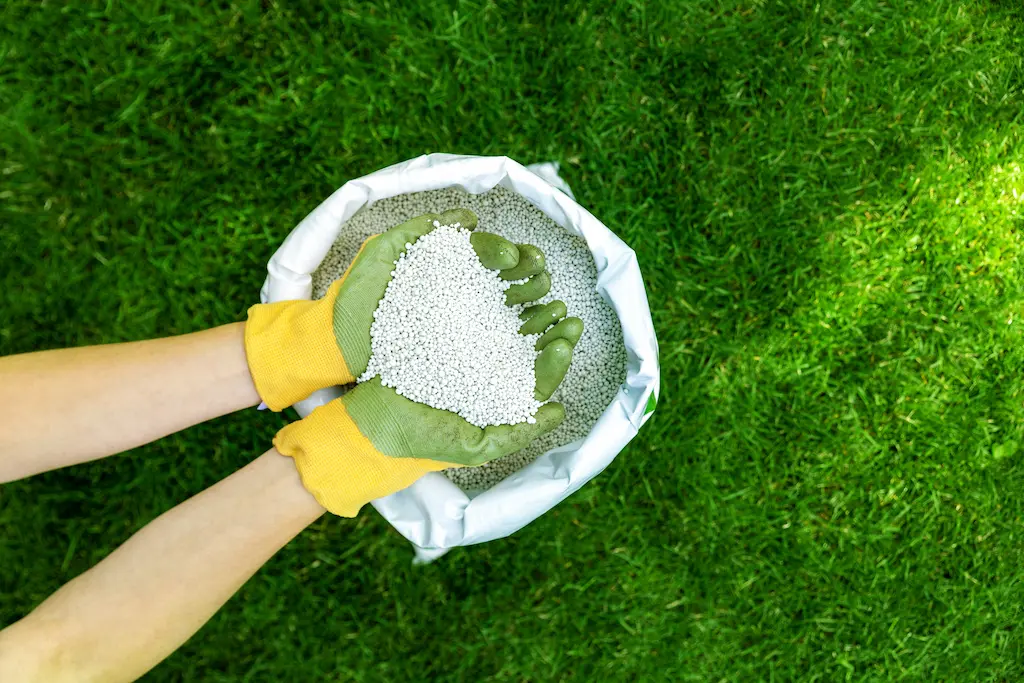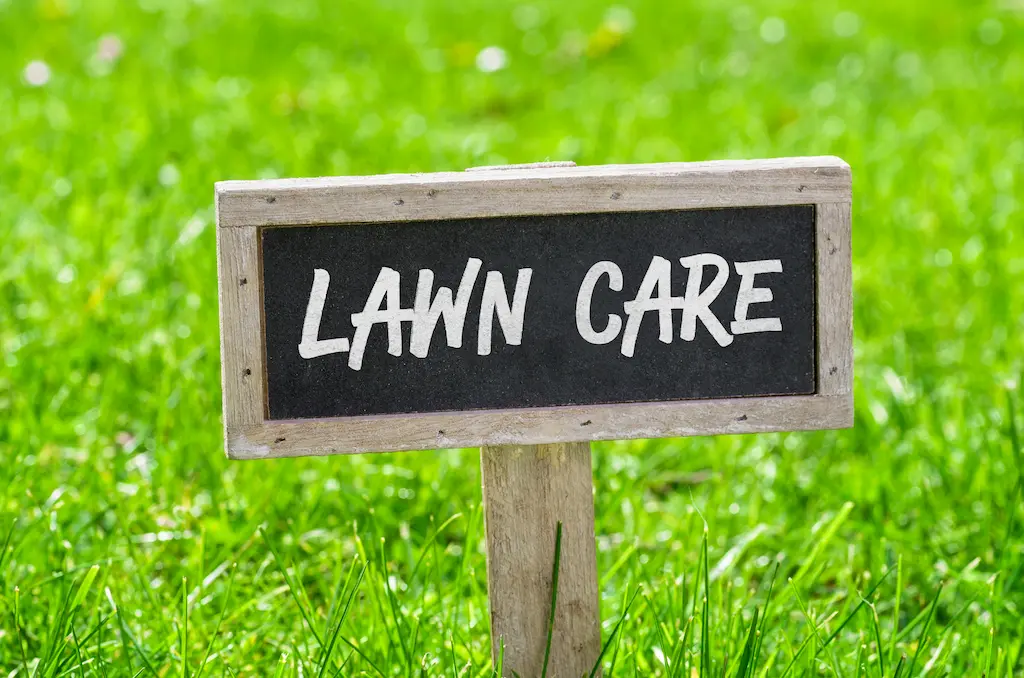It’s time for a spring clean, and that includes your lawn care, too! After a rough winter season, spring lawn care is more important than ever to bring your lawn back to fighting condition. From implementing fertilizer to preventing crabgrass, there are several steps to take with your lawn care spring maintenance to get your long prepped for the summer season ahead, and we are here to help!
To help you start the warmer season on the right foot, our team at Earth Development is sharing our must-know spring lawn maintenance checklist to prep your lawn!
When Should You Start Preparing the Lawn for Spring?
One of the most important factors in how to care for your lawn in spring is when to begin the preparations.
The spring lawn care steps should begin as soon as your lawn has mostly returned to green. While it’s tempting to begin as soon as temperatures begin warming up, doing so too soon can actually compact the soil and increase your chances of killing off new grass shoots before they’ve matured.
A key element to knowing when to prepare your lawn is the type of grass. This means understanding whether you have cool-season grasses or warm-season grasses on your lawn.
- Cool Season grass primarily grows at two different times: in the spring and in the fall. This type of grass can struggle in hot summer temperatures, so spring maintenance is essential to prepare it for the summer season.
- Warm Season grass typically starts growing after the final spring frost and hits its full growth around midsummer when the heat begins to really go up.
Knowing when your grass is growing is essential to preparations, as you don’t want to begin too soon as it can cause harm to your growing grass.
Spring Lawn Care Checklist
When navigating how to care for lawn in spring, there are some tried-and-true steps to take to ensure a healthier finish. From prepping your lawn mower to laying grass seed and lawn fertilizer, ensuring a healthy lawn takes expert spring lawn care. Here’s how it’s done.
1. Rake and Clean Up Your Yard

During winter, your yard has most likely accumulated debris. Your plants have most likely accumulated dead leaves and branches. You need to get all of this off your yard. Grab some gloves, and get rid of all the debris that has plagued your yard. There may be branches that have fallen off, dead grass, and maybe even some litter. You want your yard to be nice and clean for the rest of the spring cleaning tasks. The cleaner and healthier your yard is, the better your Spring will be. As a bonus, this debris makes great composting material, which is a wonderful (and green) way to put nutrients back into your soil.
After you’ve cleared all the big stuff from your yard, it’s time to rake. Raking will remove all the dead grass and leaves and anything you may have missed with your hands. Raking will also help control thatch build-up. Be sure you also clear out all the pine cones that may have accumulated in your yard. Raking will ensure your lawn is as healthy as can be for the Spring growing season.
2. Dethatch
Next up for spring lawn care is dethatching. Dethatching is the process of removing organic matter from between grass blades, which can build up and cause issues with everything from nutrients reaching the soil to grass growth and pest control. Our lawn dethatching service will remove the thick thatch layer, promoting a healthier lawn.
3. Aerate If Necessary

Lawn aeration is the process of creating tiny holes across your lawn’s soil, allowing it to receive. the necessary nutrients and hydration to promote a beautiful lawn. This is wonderful in cases where there is compacted soil, or your soil isn’t getting the nutrients it needs. With so many small holes across your soil, lawn aeration can be a tedious process, and one that our professional lawn aeration services can take off your plate. Especially after the winter season, aeration is an essential step in your spring lawn care checklist.
4. Mow High
Did you know there’s actually a proper amount of grass to cut with your lawn mower? To promote a healthy lawn, get your lawn mower ready to cut just 1/3 of the blade’s length with each mow and no more. Typically, a healthy green lawn should have blades of grass around 3 to 4 inches high. To accommodate this, adjust your mower to cut at the highest setting for your type of grass.
Keep in mind, short grass means shallow roots, which will come under more stress if there’s a drought. Deeper roots are essential to a resilient lawn, so keeping tall grass with deep grassroots will not only promote hydration but better compete with weeds, too.
5. Overseed
Spring is a great time to start planting any trees, perennial flowers, or shrubs you’ve been wanting in your yard. You can even start a new lawn or overseed your lawn to make up for bare spots in it. However, be careful if you have applied a pre-emergent for weed control. If you are doing weed control in the Spring, it is best to wait for Fall to overseed your lawn.
6. Kill Lawn Weeds
It’s best to always plan for weed control. It’s easier to try to prevent them before they emerge than to have to weed constantly. For your lawn, it’s best to use a pre-emergent, especially for crabgrass prevention. Crabgrass will start popping up when temperatures get into the 50s. That’s why it’s best to use your pre-emergent in early Spring. For pest control, it’s best to just stick to deer-resistant plants. To ward off ticks, you can spray your lawn in the late spring.
7. Fertilize

As part of your spring lawn care, be sure to use lawn fertilizers appropriately. When you are preparing your flower beds, old and new, it is a good idea to apply fertilizer. You want to nourish your soil back to health after the harsh winter. Consider using compost in the Spring as your fertilizer. Your plants will appreciate composting most in the Spring. If you’re using a chemical fertilizer instead, follow the directions and don’t use it in excess.
Keep in mind, you won’t necessarily need to use fertilizer on your lawn in the spring, especially if you did in the fall. To determine if you should fertilize, use a soil test kit to check the nutrient levels with a soil sample. in your lawn and see if you need some added help to promote beautiful grass.
In addition, when exploring fertilizer, ensure you know how to choose the best fertilizer for your lawn. Different fertilizers are best suited for various grass types, so be sure you choose the right one for your grass type.
8. Eliminate Grubs
Last on your spring lawn care checklist is eliminating grubs. Grubs can do a great deal of damage to your lawn, harming root growth, and grass health, and ultimately preventing a healthy, lush lawn. If they go unaddressed, grubs can leave your lawn looking worse for wear. With this in mind, address any grubs, insects, and fungi early in the season, ensuring you prevent lawn disease and bare patches for a healthy lawn.
With integrated pest management, you can ensure your lawn stays healthy and pest-free, equipped against the numerous pests that can do harm. With proper prevention, monitoring, and control methods, our team can help ensure your lawn kicks off on a healthy note this early spring.
Spring Lawn Care Tips from Experts

We aren’t done with all our spring lawn care tips quite yet! With a team of experts with extensive experience handling early spring lawn maintenance, we have some additional preparation tips for when spring arrives. Here’s what we recommend.
Tip #1: Check Your Hoses
Ensure you always start the gardening season with tools equipped for the work. One of the most important elements of this is a well-functioning, sturdy hose.
When looking for a hose this spring, ensure you buy one that’s long enough to water the entire lawn, reaching all corners and flower beds with ease. Typically, a hose will come in lengths from 25 to 100 feet, so ensure you purchase the one that best suits your lawn size.
Tip #2: Get Your Lawn Mower Ready for the Season
Ensure you’re ready to start mowing as soon as your grass is ready. Before the first mowing, consider having your mower serviced. This will ensure it’s ready for the growing season, checking that the starter, air filter, belts, spark plug, and battery are all well-equipped for the new grass.
As part of this process, rake your lawn to remove fallen leaves and twigs. When mowing for the first time, set the mowing height to around 1/2 inch lower than usual to break up the debris. After that, set it back to cut no more than one-third of your grass height to avoid harming your lawn.
Tip #3: Water the Right Way
There is a right way to water your lawn! As part of our spring lawn care tips, we recommend avoiding watering too early. When grass begins to grow, the roots are what grow first, and they will grow deeper in the soil if it is slightly dry. This way, they are better equipped to survive drought stress. That being said, if your lawn doesn’t spring back after you step, it’s time to water.
Tip #4: Fill in the Blanks with Seed or Sod
Last in our spring. lawn care tips are filling in the blanks. You don’t want to leave bare patches across your lawn. To avoid this, spread grass seeds or a sod patch over these sparse areas to fill them in, ensuring a full, healthy lawn.
Keep in mind, good soil contact is essential to this. As part of this, be sure to loosen the surface of the soil with a rake before beginning.
Conclusion
Undoubtedly spring is a wonderful time of the year. However, with the arrival of spring, your site requires great maintenance. From laying new grass seed to knowing whether you are dealing with warm or cool-season grasses, there are a number of spring lawn care tips that can help you better promote a healthy, lush lawn. So, as you begin your spring cleaning indoors, take your attention to the outside, too, with expert spring lawn care to withstand the seasons ahead.
Looking for a seasoned partner for your commercial property’s spring lawn care? We’ve got you covered. With over 20 years of providing expert lawn care across the Midwest, including Green Bay Milwaukee, and Minneapolis, we are proud to share our spring lawn care steps with you. Contact us at Earth Development and we will help you restore your lawn to perfect condition with our professional lawn maintenance services.
